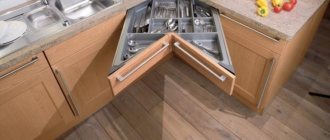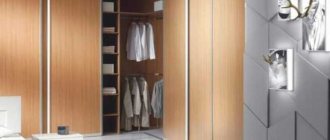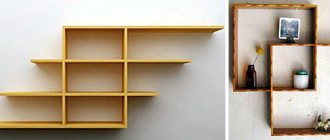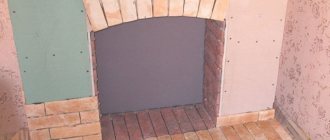One of the most common problems with modern kitchens is the lack of usable space. Lack of space often prevents the free placement of all necessary furniture and equipment. There are several common options that allow you to save useful space. A corner kitchen sink is an ideal purchase in this case, as it makes it possible to use a free corner area.
Externally, corner sinks can be presented in the form of bowls of various shapes and configurations
Advantages and disadvantages of corner kitchens with a sink in the corner: photos
It’s worth saying right away that corner sink models are most often installed in kitchens that have an “L” layout. This method of placing a kitchen unit is characterized by maximum functionality with minimal use of usable space.
If the kitchen is not large enough, then it would be appropriate to think about installing a corner sink.
Installing a sink in the corner of the kitchen allows you to save quite a lot of space. As a result, this makes it possible to install a larger countertop. The freed up space can be used for other purposes, for example, adding additional drawers for storing kitchen utensils.
A kitchen with a corner sink is primarily about comfort and convenience. Currently, the market for such equipment is overflowing with models for every taste. They differ from each other in the following indicators:
- material of manufacture;
- dimensions;
- shape;
- colors.
The only disadvantage of corner sinks is the specificity of their location, because washing dishes while standing in the corner may not be physically convenient
The variety of models allows you to choose the right sink that matches a specific interior. This type of design ensures that the working areas are close to each other. There is quite a lot of free space under it, which makes it possible to place a trash can and other necessary items in the kitchen. It is also worth mentioning the more presentable appearance of corner kitchen sinks. Photos help to verify this.
Such models also have some disadvantages. It is not recommended to purchase oversized sinks, as the corner in this case may turn into a “dead zone”. This rule applies not only to the bowls themselves, but also to the furniture that is installed under them. If you wish, you can purchase a corner kitchen sink with a cabinet that comes with it. This will help avoid incompatibility of equipment with furniture.
Another disadvantage is that corner sinks are usually equipped with a cabinet that has small doors. This makes it difficult to carry out repair work if the sink fails.
Helpful information! To install the most suitable sink, it is recommended to consider all possible options for bowls and their components.
Compactness is one of the strengths of corner sinks
Corner sink for the kitchen: varieties based on material of manufacture
Corner sinks used for washing dishes are made from different materials. Each of them has its own technical characteristics and, accordingly, pros and cons. The following materials are most often used to make sinks:
- stainless steel;
- ceramics;
- stone (artificial and natural).
Stainless steel. Products made from this material are the most common. This is due to the fact that they are affordable. Corner kitchen sinks made of stainless steel can have a matte texture or a glossy surface. Products of the second type are easier to maintain, which is why many experts recommend purchasing them.
Another advantage of stainless steel sinks is their versatility. They have a simple design and can be combined with any type of kitchen interior. Stainless steel is resistant to corrosion. Among the disadvantages of such sinks, it is worth noting their noise. Corner kitchen sinks made of stainless steel are also easy to install, so installing them yourself will not be difficult.
Metal sinks look especially good in classic and traditional kitchen interiors.
Ceramics. Sinks of this type are distinguished by a presentable appearance. Most often, classic white ceramic products are found, but there are also colored models. The main advantage of such sinks is their resistance to moisture and active chemicals used for washing dishes. The disadvantage of such products is their large mass, which complicates transportation and installation. It is also worth noting that chips may occur on the ceramic surface over time.
Artificial and natural stone. Such models belong to the upper price category. The advantages of these sinks are their elegant appearance and long service life. Corner sinks for kitchens made of artificial stone are resistant to aggressive chemicals and high temperatures. The variety of options for products made from this material is very wide.
Natural stone is more expensive than artificial stone, but is considered a more reliable material. Sinks of this type absorb the noise of water flowing from the tap, which is also a big plus.
Today, kitchen sinks are made from various materials with good quality characteristics.
Requirements for corner sink models
The choice of plumbing fixtures is most often made taking into account the individual characteristics of the kitchen space and the personal taste preferences of the owners. However, there are still several important points that you should pay attention to before purchasing a sink.
Before purchasing a corner kitchen sink, you need to calculate its volume. This indicator is selected depending on the personal needs of the kitchen owners. It is necessary that the sink accommodate a certain amount of dishes used during meals for all family members.
Bowls must have good resistance to high temperatures. Otherwise, the service life of the plumbing equipment is reduced several times. It is also very important that the sink is resistant to mechanical stress (impacts).
Experts advise taking the selection of furniture for a corner sink seriously. Kitchen sink cabinets may vary in size, material and design.
The universal size of bowls for any sinks, including corner ones, is a depth of 16-20 cm
Not only corner models, but also any other sink options must have good resistance to aggressive chemical compounds contained in detergents.
Note! Stainless steel products are best able to withstand temperature changes.
And finally, before purchasing this plumbing fixture, you need to determine in advance the place where it will be located and take the appropriate measurements. Kitchen designs with corner sinks can be studied on the Internet. This will allow you to select the required product.
There are two ways to install this type of kitchen sink – with the help of specialists or on your own. In the second case, it is recommended to study the installation instructions and strictly adhere to the sequence of actions that are described in it.
The guidelines for action when choosing sinks should be the dimensions of the kitchen furniture
Choosing a sink - type, shape, material
The choice of size and shape of the kitchen sink directly depends on the area of the kitchen. All sinks are divided into 3 types:
- round;
- square;
- modified previous options (oval, rectangular, with beveled corners, etc.).
The most popular are round products. There are the following types of sinks:
- With one bowl, which can be round or square. The first one is more spacious and suitable for small kitchens, therefore it is more common.
- With several bowls. Installed if there is free space in the kitchen. The tap is placed between the bowls or at an angle to them.
- With two bowls of different sizes. The smaller part of the sink is used for washing fruits, vegetables or defrosting food.
- Corner with several bowls.
- With additional work surface. The space is primarily used for drying clean dishes. Some sinks have holes for draining water. Sinks have one or more bowls.
There are different volumes of bowls on the market, but you should not choose too small. When the tap is running, splashes will fly out of the sink. Shells are made from the following materials:
- stainless steel;
- ceramics;
- artificial stone, which is divided into 2 types:
- acrylic;
- agglomerate.
- wood or stone.
The most common material is stainless steel. Nickel and chromium, which are included in the composition, contribute to a long service life without loss of appearance. Sinks can have a glossy or matte surface, ornament or texture. You can make a cabinet under any kitchen sink with your own hands. Making the item yourself is especially suitable in the case of non-standard shapes or sizes of the sink.
If the choice of product shape is determined by the taste of the owners, then the number of bowls is always dictated by the size of the kitchen. You should consider not only the area of the room, but also the overall design.
What are the different ways to install corner kitchen sinks?
Modern models of corner sinks are classified according to the installation method. Depending on this criterion, all products of this type are divided into two large groups:
- invoices;
- mortise
Invoices. Sinks belonging to this class have special sides. By means of them, the bowl is fixed to the tabletop. A fairly common option is that the overhead sink contains special “wings”. They are used to store dirty dishes.
Stainless steel is most often used to make such sinks. A kitchen sink with a cabinet has its drawbacks. The main one is the limited selection of products.
Mortise. This type of sink is considered more modern and functional. These types of sinks are mounted directly into the countertop. For this, a niche corresponding to the dimensions of the bowl is prepared in advance.
Sinks come in overhead sinks (they are held in place by protruding sides) and mortise sinks (they are sunk into the countertop)
In this case, the sink can be placed at different levels relative to the plane of the countertop. It can be placed above the tabletop, on the same level with it, and also below the surface. It is worth noting that models made of porcelain stoneware and installed in this way look the most presentable (photos of kitchen sinks allow you to verify this).
The advantage of this installation method is that it saves useful kitchen space. Corner mortise models look very impressive and can be combined with almost any type of kitchen set. Such sinks are much more difficult to install yourself. This is due to the need to ensure reliable waterproofing.
Helpful information! Overhead models are most often sold with a cabinet, while mortise models are purchased separately.
The choice of installation method depends on the design features of the kitchen unit and the personal preferences of the owners of the room. Before starting installation (if you do it yourself), it is recommended to read the instructions.
The sink can be located flush with the countertop or below and above the surface
Sink installation
When the frame for the kitchen sink is made with your own hands, the sink is installed. Installation options will depend on the design features of the sink. The standard version is fixed in two ways:
The first option is only suitable if the sink is light. When the structure is heavy, it is necessary to use self-tapping screws. Otherwise, the sink may fall. Before installation on the sealant, all ends of the cabinet are coated with a connecting mixture. Then install the shell and press on it for better adhesion.
To mount the sink on self-tapping screws, buy special L-shaped fasteners. In total you will need 4-5 pieces. They are screwed at the same height from the inside of the cabinet. For accuracy, it is advisable to use a building level. To protect the cabinet material from moisture, the ends are lubricated with sealant, and a sink is installed on top. The fasteners are placed on self-tapping screws and moved along the slot. This presses the sink against the cabinet.
Choosing the shape of a corner kitchen sink: recommendations
One of the most important parameters of shells is their shape. There are both standard models of this plumbing equipment and less common options used for corner kitchens. A sink in a corner with incorrectly selected dimensions or configuration can cause many difficulties, so it is very important to study the possible options for product shapes:
- round;
- square;
- rectangular.
Round sinks are very popular in the modern market. The advantage of such sinks is that they have a large volume, which is determined by the peculiarities of the shape. This sink harmonizes perfectly with a variety of interiors.
Round bowls have another serious advantage - they are quite compact. Therefore, experts recommend buying such models for small kitchen spaces. Round sinks, as a rule, are sold together with a corner module for the kitchen under the sink. The absence of corners helps to improve the hygienic performance of this design, since it is less prone to the accumulation of contaminants. It is also worth noting that round sinks have a wide range of models.
The shape and depth (volume) of the bowl for a corner sink can vary significantly
The classic version of sinks is square. Such products are highly functional in any kitchen. The dimensions of the room in this case do not play a role. These sinks are suitable for both spacious kitchens and small rooms.
Square models most often have a side wing, which is necessary for storing dishes, but they can be sold without this element. Corner sinks with a cabinet having this shape are also installed directly into the countertop. Thus, square models are the optimal solution. The cost of such sinks is quite reasonable.
Rectangular bowls for washing dishes are currently considered the most popular. They are distinguished by functionality and versatility. Such models can be overhead or mortise.
Sink sizes: how to choose the required dimensions
The parameters of the kitchen sink are a very important indicator, according to which the required option is selected. Before buying a sink, you need to measure the free space in the corner. It is recommended to always allow for a small margin.
Before purchasing and installing a corner sink, be sure to carefully measure the location where it will be installed.
Corner models can differ in a wide variety of dimensions. For example, even a sink that is compact in width can have quite a significant depth. When choosing the size of a corner sink, there are several important factors to consider.
First of all, the selection of parameters is carried out in accordance with the size of the kitchen furniture itself. It is also very important to consider what kind of utensils owners most often use for cooking. In addition, you need to take into account the height of the tabletop.
Note! If the kitchen has a dishwasher, then purchasing a deep sink is not a prerequisite.
It is very important to choose the correct depth of the countertop. This determines whether water will flow outside the bowl when the tap is turned on. The optimal sink depth varies from 16 to 20 cm. These indicators are quite enough to ensure comfortable washing of dishes. There are several rules that allow you to choose the right size corner sink for your kitchen. Photos of various models are also recommended for study.
Externally, a small sink may well have significant depth, and vice versa
If the height of the kitchen sink cabinet is 85 cm, then it is strictly not recommended to purchase bowl models whose depth exceeds 20 cm. Such dimensions ensure convenient use of the sink. These sinks are suitable for washing not only plates, but also larger dishes (pans, pots, etc.).
Corner cabinet for kitchen sink: design drawing
A drawing of an attached cabinet under the sink is needed if you are planning to make the design yourself. By the way, this is not so difficult, and if you made some other elements for the kitchen on your own, then you can handle the cabinet.
Before designing a drawing, decide on the following:
- The purpose of a bedside table is whether it is just a device for washing, or a storage space, etc.;
- Decide on the size of the cabinet as a whole and its components;
- Calculate the distance between the internal shelves, if any;
- Decide on the color of the bedside table and design;
- Select the material;
- Based on the information collected and the most accurate desired photographic sample, draw up a drawing.
It is much easier to assemble a cabinet using a drawing, and the assembly will be clear, where everything goes clearly according to plan. The finished standard drawing can be obtained on the Internet.
DIY drawing of a corner cabinet for a sink (video)
Kitchen sink with cabinet: types and their characteristics
Choosing furniture for a corner sink requires understanding the compatibility of the elements of the set with each other. As a rule, plumbing fixtures, as well as furniture for them, are selected taking into account the interior of the kitchen. In this case, you should take into account the color and design of the kitchen corner set. Sometimes the choice of cabinet depends solely on the bowl itself.
It is worth noting right away that modular kitchens do not always represent cabinets corresponding to other elements of furniture. In the kitchen, all individual components of the set must, in one way or another, have maximum functionality. Cabinets are no exception. A competent choice of this furniture unit allows you not only to place a trash can and various cleaning products under the sink, but also to integrate appliances into this space. Placing the dishwasher under the sink is a fairly common solution.
Straight cabinets for sinks are most often equipped with two doors and are more functional
All cabinets are classified into two groups depending on the design features. Each type has its own advantages and disadvantages. There are the following options for kitchen cabinets:
- straight;
- with a beveled corner.
Models that fall into the straight category most often include two doors. They can also have one folding door. In some cases, they are made in the form of a double structure, but this version of the cabinets is much less common. If desired, you can purchase a cabinet under the sink, which has drawers used for storing various kitchen utensils.
A cabinet with a beveled corner is a less popular solution. The thing is that its installation requires compatibility with a corner sink, and not all models are suitable for such a cabinet.
Helpful information! Experts do not recommend buying a beveled model if the sink is large. This design prevents free access to the far corner.
In order to free up space in the kitchen, you can arrange a corner work triangle, the center of which will be the kitchen sink with cabinet
Corner sink with cabinet for the kitchen: dimensions of designs and features of their choice
Before purchasing a kitchen sink, you need to decide on its optimal dimensions. To do this, use a tape measure to measure the free space in the corner of the room.
The single version of the design is most widely used in the domestic market. This is due to the fact that such sinks take up much less space, which is an advantage for standard kitchen spaces that do not have a large amount of free space. A double corner kitchen sink, among other things, is more expensive.
Most often, corner cabinets are selected depending on the size of the sink itself. This is very important, since devices that are incompatible with each other cannot be installed. The size of the corner cabinet (classic) is 60 cm. This indicator corresponds to the width of the furniture. These dimensions are quite enough to hide communications under the sink, as well as to place household chemicals and a trash can.
If the width of the sink is 50 cm, then the best option in this case is to choose a cabinet that has the shape of the Latin letter “L”. This solution allows you to save usable space in the working area, which is very important.
The depth depends on the type of corner sink (countertop or mortise) and the shape
As for the parameters of sinks and cabinets purchased for spacious kitchen spaces, in this case there are no size restrictions. Corner cabinets for kitchen sinks are also selected according to the material they are made of. They can be made from the following raw materials:
- chipboard;
- MDF;
- natural wood.
Chipboard is the least expensive material available. This option is recommended by experts in order to save money. Corner floor-mounted kitchen cabinets made of MDF are a little more expensive, but they have a higher resistance to moisture. The price of wooden cabinets is the highest, but this is justified by the good quality of such furniture intended for the kitchen area.
Additional accessories
Accessories for corner kitchen sinks can be boards for cutting ceramic or wood products, colanders, built-in containers for cutlery, and various food waste grinders. Accessories for kitchen sinks made of composite materials can include all kinds of cutting boards and wooden blocks for installation. In addition, corner sinks often come with a variety of water filtration devices.
Manufacturers offer the following accessories for cooking and working with food:
- basket for storing fruits and vegetables;
- grid for holding large waste;
- sink insert for defrosting meat or fish;
- pallet;
- liquid soap dispenser;
- colander-overlay for drain;
- dryer for towels and dishes;
- and other accessories.
Accessories are necessary to make work in the kitchen easier, reduce time wastage and make washing dishes more enjoyable. Their photos can be easily found on the Internet.
Kitchen with corner sink: where to place the sink
The location of the kitchen sink is selected taking into account the ease of its use. The sink in bathrooms, as a rule, is located in such a way that its entire body is located above the cabinet. This option is not suitable for the kitchen, since in this case it will be difficult to wash the dishes.
Placing a sink in a corner makes moving around the kitchen more efficient
Before installing these devices, it is recommended to study ready-made placement options, which can be seen in the photo. The prices of corner kitchen sinks and their capabilities are directly related. The corner type design allows you to create two work areas, which is very convenient. The advantages of this arrangement are very significant, since standard sink options do not allow you to cook several dishes at once.
Note! The angular position of the sink is not always a winning solution. For example, this option is not suitable for short people due to the presence of a “dead zone”.
If cooking in the kitchen is carried out by more than one person, then in this case it is also better to refuse to purchase a corner sink. The cabinet under the sink is selected depending on the dimensions of the bowl itself.
Nowadays, placing the kitchen sink near the window is gaining popularity. This option for placing plumbing fixtures is common in European countries. In this case, the stove and countertop are located along the wall.
Corner kitchen sink located by the window
Design features of corner sinks: color and accessories
The choice of color depends on the style of the kitchen. A wide variety of sink models allows you to choose the necessary colors that will harmonize with the design of your kitchen unit. The corner cabinet for the sink is also selected according to this principle.
The classic version of the bowl is white. Such sinks are suitable for almost any kitchen, which is why they are popular among buyers. Another common type is metallic-colored products. They are made of stainless steel.
Purchasing a stone sink will allow you to choose not only the right color, but also the design. Models made of artificial black marble look elegant and presentable. Stone products can come in a variety of colors, but neutral shades are the most popular. A corner kitchen sink with a cabinet, made of gray and white stone, will decorate any room, regardless of its style.
When purchasing such plumbing fixtures in stores, they often offer to buy additional components for it. Some accessories can be very useful in everyday life. Most often, containers are sold along with sinks that are used to store brushes, soap dishes, as well as boards for cleaning and cutting vegetables and fruits.
Today there is a wide variety of sink colors on the market, so you can choose it to suit any kitchen interior.
Preparatory stage
The sink cabinet is one of the simplest in design; even a novice craftsman can make it. Moreover, all such objects are similar in design to each other. The only exception is the internal contents - the location of the shelves and so on.
Materials you need to prepare:
- two side walls;
- bottom;
- two upper struts;
- doors - one or two, depending on the design and width of the bedside table;
- lower plinth;
- wooden pins and furniture screws;
- furniture hinges.
The most suitable material that can be used to make a kitchen cabinet is chipboard or MDF, as well as boards for the baseboard and spacers. The following tools will be required:
- screwdriver;
- drill;
- hand-held circular saw for cutting chipboard and boards.
When making a sink with your own hands, its dimensions will depend on the dimensions of the sink, which is mounted in the cabinet, as well as the size of the room where this furniture will be located. You can make a wide bedside table in which the sink will be combined with the countertop.
How to make a cabinet for a sink? The most common option is a cabinet with a width of 400 to 800 mm. Double models can have a width of up to 1.2 meters, if the dimensions of the kitchen allow. The standard dimensions of the sidewalls remain the same regardless of the width and are 530x814 mm, where 814 mm is the height and 530 mm is the bottom depth.
The width of the bottom is formed on the basis that the dimensions of the thickness of the chipboard from which the sidewalls are planned to be made will be subtracted twice from the total width of the cabinet. For example, if the total width is 800 mm, as in the figure below, then the width of the bottom, provided that the chipboard has a thickness of 14 mm, will be calculated as follows: 800-14-14 = 772 mm. The spacers and bottom plinth have a length equal to the width of the bottom. The width of the doors is selected based on the width of the cabinet, but the height is a constant value. The width of the doors will have to be calculated very accurately and carefully. If an error is made in the calculations, the doors either will not close, or an unsightly wide gap will appear between them.
Below are drawings of the main parts:










